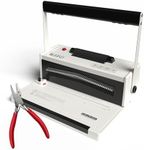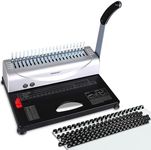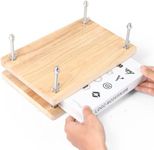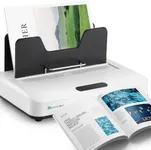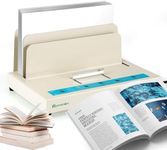Buying Guide for the Best Spiral Binder Machines
Choosing the right spiral binder machine can make a significant difference in the efficiency and quality of your document binding tasks. Whether you need it for personal use, small business, or large-scale operations, understanding the key specifications will help you make an informed decision. Here are the main factors to consider when selecting a spiral binder machine.Punching CapacityPunching capacity refers to the number of sheets a machine can punch at one time. This is important because it affects how quickly you can prepare documents for binding. Machines with a lower punching capacity (10-15 sheets) are suitable for occasional use or small projects. Medium capacity machines (15-25 sheets) are ideal for small to medium-sized businesses. High capacity machines (25+ sheets) are best for large-scale operations or frequent use. Consider your typical document size and frequency of use to determine the right punching capacity for you.
Binding CapacityBinding capacity indicates the maximum number of sheets that can be bound together in a single document. This is crucial for ensuring that the machine can handle the size of documents you need to bind. Machines with a lower binding capacity (up to 100 sheets) are suitable for small reports or booklets. Medium capacity machines (100-300 sheets) are good for standard office documents. High capacity machines (300+ sheets) are necessary for large manuals or thick reports. Assess the typical size of your documents to choose the appropriate binding capacity.
Manual vs. ElectricSpiral binder machines can be either manual or electric. Manual machines require you to punch holes and bind documents by hand, which is suitable for low-volume tasks or occasional use. Electric machines automate the punching and binding process, making them ideal for high-volume tasks or frequent use. If you need to bind documents regularly or in large quantities, an electric machine will save you time and effort. For occasional or low-volume use, a manual machine is more cost-effective and sufficient.
Adjustable Margin DepthAdjustable margin depth allows you to control the distance between the edge of the paper and the punched holes. This is important for ensuring that the bound documents are durable and pages do not tear easily. Machines with adjustable margin depth provide flexibility for different document sizes and binding styles. If you work with various document sizes or need to ensure extra durability, look for a machine with this feature. For standard documents, a fixed margin depth may be sufficient.
Ease of UseEase of use encompasses features like user-friendly controls, clear instructions, and ergonomic design. This is important because it affects how quickly and efficiently you can complete your binding tasks. Machines with intuitive controls and ergonomic designs reduce the learning curve and physical strain. If you are new to binding or need to train multiple users, prioritize machines that are easy to operate. For experienced users, advanced features may be more important than basic ease of use.
Durability and Build QualityDurability and build quality refer to the materials and construction of the machine. This is important for ensuring that the machine can withstand frequent use and last for a long time. Machines made with high-quality materials and robust construction are more reliable and require less maintenance. If you need a machine for heavy-duty or frequent use, invest in one with high durability. For occasional use, a less robust machine may be sufficient but ensure it still meets your quality standards.


